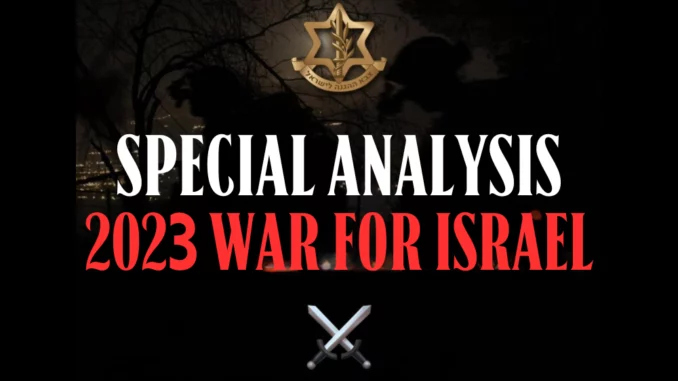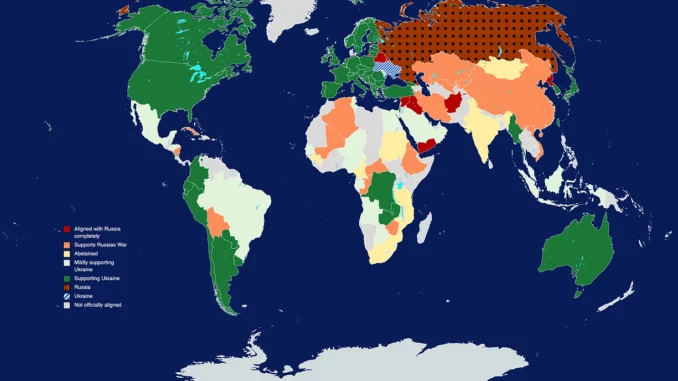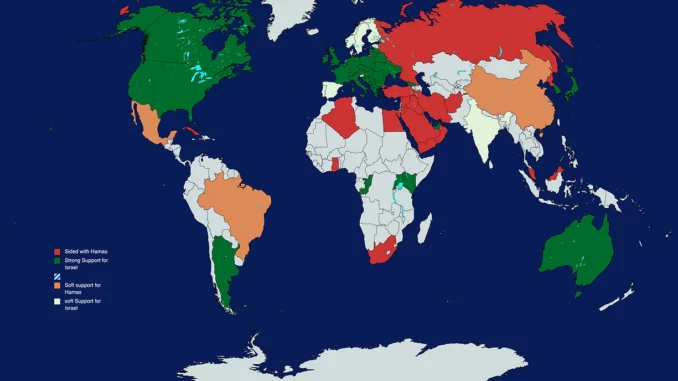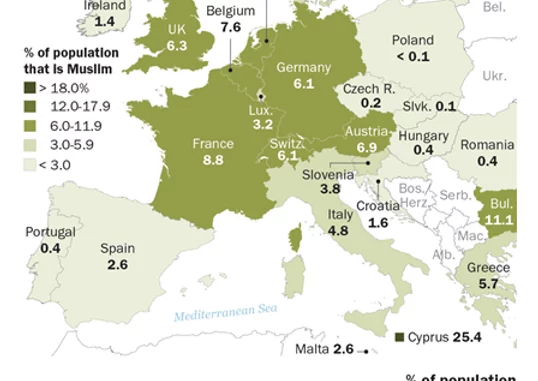by: Yishai Gelb

In the midst of an escalating conflict, the world is witnessing a struggle that transcends regional boundaries, evolving into a profound clash of civilizations. This analysis delves into the intricate alliances shaping the Ukrainian-Russian and Israel-Palestine wars, offering insights into the potential scenarios of a hypothetical World War III.
Examining diplomatic nuances in the Middle East and tensions within Muslim minorities in the West, the article explores the strategic moves of Hamas and the imperative for Israel to reshape its narrative. The evolving global landscape and the clash of cultures are thoroughly examined, highlighting the broader ideological struggle unfolding on a global scale.
After nearly three weeks of conflict, it is evident that the current war extends beyond regional boundaries, serving as a prelude to a defining struggle within the Western world. What transpires is not merely a Middle Eastern discord but rather a harbinger of a profound clash of civilizations.
This analysis aims to dissect the ultimate objectives of both Israel and Hamas, meticulously navigating through the impediments that challenge Israel’s path to triumph. Most notably, the ongoing war between Israel and the Palestinians presents an illuminating perspective on the contemporary global landscape. With two major civilizations embroiled in conflict and nations aligning themselves, this examination delves into the intricacies of strategy, geopolitics, and Israel’s strategic roadmap for the duration of this tumultuous war.
Map of Alliances
Amidst the current global landscape marked by two significant wars, a comparative analysis offers valuable insights into the potential contours of a third major conflict. The question at hand is: what would World War III look like geopolitically? Examining the alliances in each conflict provides a lens through which we can envision three distinct fronts in this hypothetical world war.
The initial focus is on the Russian-Ukrainian war, with the first map illustrating the alliances involved. Following this, attention shifts to the Israel-Palestinian war, with the subsequent map delineating the alliances in this particular theater of global tensions.
 <
<
Map of alliances: Ukraine-Russia War
 <
<
Map of alliances: Israel-Palestine War
Unraveling the layers inherent in the geopolitical tapestry, a comprehensive analysis of two pivotal conflicts provides a nuanced understanding of global dynamics:
Middle East:
The Ukrainian-Russian conflict unveils a cautious dance among nations, strategically avoiding unequivocal alignment to preserve delicate relationships with both the United States and Russia. In stark contrast, the Israel-Palestine war exposes a cohesive front in the Middle East, where regional states uniformly rally behind Palestine. The rationale behind this alignment becomes evident—a demonstration of Arab solidarity, even at the perceived cost of antagonizing the United States.
However, beneath this unified stance lies a labyrinth of geopolitical calculations. Are Sunni Arab states, in their public denunciation of Israel, clandestinely supporting its objective of weakening Iranian proxy forces? The imminent global war scenario poses a compelling question: Will the Middle East’s alliances mirror the intricate web of the Ukraine-Russia war, with nations strategically positioned on a spectrum of alignment? Alternatively, will it align more closely with the stark divisions witnessed in the Israel-Palestine war? The answer, it seems, hinges on the fragility of the Western alliance, unraveling from within.
Developing World
A closer examination of Africa and Asia reveals a conspicuous schism in alliances. Major players like India, Brazil, and Mexico adopt a diplomatic tightrope, avoiding definitive alignments in both wars. The European theater, marked by the proxy war between the United States and Russia, affords countries like India an opportunity to leverage low energy prices while maintaining a semblance of stability in relations with both global powers.
The Israel-Palestine war, however, transcends regional boundaries. It morphs into a symbolic battleground for a broader ideological conflict—pitting defenders of the West-led order against those aspiring to reshape global governance under the influence of authoritarian regimes. Democracies openly rally behind Israel, while authoritarian regimes align themselves with Iran and the Palestinian cause, challenging the established world order.
The Palestinian narrative is that Israel is a colonizer, an occupying force in the Middle East oppressing the local peoples. Since Israel is the actual aggressor, then any violence done towards Israel is justified. Palestinian resistance is Justified. This narrative isn’t just the story of the pro-Palestinians. Many developing countries view the US-led world order as a continuation of European colonization.
Central to this narrative is a palpable global sentiment against Western influence, a sentiment echoed by nations seeking alternatives to what they perceive as a continuation of European colonization—the U.S.-led world order. This sentiment resonates not only among the nations involved in the Israel-Palestine war but finds expression in the larger global arena. Countries such as South Africa, Zimbabwe, Congo, Mali, Ghana, Algeria, Brazil, and others actively resist Western influence, embracing Chinese and Russian partnerships.<
In essence, Israel’s war against Hamas transforms into a broader ideological struggle—a war against Palestinian resistance to the state of Israel and, more fundamentally, against forces seeking to dismantle the Western-dominated world order. The narrative advanced by both sides encapsulates the global struggle for influence and control, reaching far beyond the confines of the Middle East. It underscores a paradigm shift, where the fight for human rights, liberty, freedom of speech, and the pursuit of happiness is no longer confined to regional conflicts but extends its reach into the heart of the Western world, Europe, and potentially the United States—a resounding call for the defenders of freedom to brace for a new era of global conflict. <>
Muslim minorities in the west
In the last two decades, Western democracies, driven by the progressive elite, opened their doors to immigration from Middle Eastern and North African countries. The rationale behind this had two main pillars. Firstly, facing declining birth rates, leaders sought to replenish their populations with young immigrants who could contribute to the workforce and economic growth. This was evident in countries like France, Germany, Sweden, Denmark, England, Austria, and others. The second pillar was the globalist agenda, envisioning a borderless world where nationalism was considered obsolete.
However, the clash of cultures has proven to be more profound than anticipated. The assumption that diverse cultures could seamlessly coexist is now being challenged. Western values of freedom, human rights, and economic prosperity collide with the more authoritarian mindset prevalent in the Middle East and North Africa, emphasizing honor, religious teachings, and collectivism. The cultural clash is just beginning to unfold in Europe and the USA, exacerbated by the fact that Western populations are not reproducing at replacement rates, while Muslim immigrants have larger families. What started as a small minority is growing into a significant demographic force that has the potential to reshape countries at their core.
Looking at the numbers, Germany has 4,600,000 Muslims (5.6% of the population), France has 5,700,000 Muslims (8.6% of the population), Belgium stands at 8.7%, Austria at 8%, Canada nearly 5%, and the USA slightly over 1%.<
 <
<
Recent pro-Palestinian demonstrations across Europe and Western countries have underscored this clash. The demonstrations echoed an anti-Western narrative, justifying violence against Jews as retaliation for perceived Israeli aggression. This has raised concerns about cultural differences that tolerate acts such as rape, murder, mutilation, and burning people alive.
United States
<
Europe
<
Berlin
<>
Washington
<
Hebron
<
Europe
<
The growing influence of this minority poses a significant challenge. Authoritarian Muslim countries in the Middle East closely observe these developments, and their alliances may hinge on Europe’s ability to assert strength and uphold Western values. The repercussions extend globally, as the United States may find itself unable to single-handedly maintain the world order and alliances that have been pivotal in shaping the international landscape. This realization is not lost on groups like Hamas, which strategically exploits these dynamics in its conflict with Israel.
Hamas Strategy
Hamas employs a cunning strategy, leveraging Western media and progressive ideologies to justify its conflict with Israel. Recognizing its military limitations, Hamas aims to extract concessions from Israel through a gradual process.
-
Step one involves provoking Israel by launching rockets and conducting terrorist attacks, targeting civilians.
-
Step two anticipates Israel’s forceful response, setting the stage for the next phase.
-
Step three strategically places Palestinian civilians in harm’s way, creating a volatile situation.
-
Step four exploits casualties to portray Israel as brutal, knowing Western media often gauges moral high ground based on casualty numbers.
-
Step five triggers international pressure to halt Israel’s response, aiming for concessions.
This recurrent strategy has historically proven effective, leading to substantial concessions. Noteworthy instances include Israel’s return of the Sinai Peninsula to Egypt in 1978 following the aftermath of the 1973 Yom Kippur War, the inception of the Oslo Accords in 1993 subsequent to the first intifada of 1989, and the withdrawal from the Gaza Strip in 2004 in the aftermath of the second intifada.<
The discernible pattern underscores a strategic imperative: the utilization of violence as a catalyst for eliciting concessions. The implicit directive is clear—sustain a continuum of violence to extract desired outcomes.
The ultimate goal is to erode Israeli territory, weaken nationalist sentiments, and promote multiculturalism within Israel. By pressuring Israel from within, Hamas aims to secure concessions over time.<
Israel, however, must not allow Hamas to dictate reality based on this strategy. Instead, it must assert its own strategic vision to shape the course of events.
Israels Strategy
While Israel boasts a powerful military, its propaganda efforts fall short. The Palestinians garner backing from both the authoritarian and Western spheres, winning the battle of perception on Israel’s home turf.
To turn the tide, Israel must tap into Western anxieties. It’s time to highlight the true conflict at hand—the clash of civilizations. Israel must synchronize its struggle against Palestine with the European battle against Russia and the American conflict with China. Key steps must be taken for this alignment to succeed.
-
-
Israel isn’t fighting the Palestinians. Israel is fighting ISIS.
-
Israel is fighting alongside the West against authoritarianism.
-
Israel is protecting the Western world order in the Middle East.
-
The world should be taking notes on how Israel deals with radical Islam, because its growing in the West as you read this sentence, and it is this generation of Europeans that will have to fight to preserve their countries. In 10 years Germany will turn into “Gerabia”. In 10 years, Belgium will be “Belgistan”. In 15 years, England will turn into “Englastan”.wn the global narrative:
-
The Palestinians aren’t fighting for a state of their own, the Palestinians are fighting to wipe Israel off the map.
The most prosperous Palestinians live in Israel. A Palestinian state is a death sentence for Palestinians. Just look at Gaza. Self governs for 15 years.
-
The Palestinians value death more than they value life, and therefore you cannot have peace with people who are willing to kill their own as a part of their strategy to reach “peace”>
-
If Palestinian media teaches their young to stab Jews, then why wouldn’t young Palestinians stab Jews? >
-
Free Palestine is a slogan for the ethnic cleansing of Jews.>Own the internal narrative:
-
-
Prepare for the worst
The conflict with Hamas in Gaza might escalate into a broader confrontation involving Iran’s proxies in the region, such as Hezbollah in Lebanon, Syria, the PLO in Judea and Samaria, and Iran itself. While it’s crucial for Israel to neutralize Hamas’s threat from Gaza, there’s a recognition that this might unfold on additional fronts. The Israeli public needs to acknowledge the potential for a prolonged and costly war. If a third front emerges globally, involving the USA and China, Israel may find itself fighting alone.
Even in a regional scenario, Israel can’t rely entirely on full US support for a major multi-front war. The White House has made it clear that a conflict between Hezbollah and Israel doesn’t guarantee direct US military involvement.
In the event the conflict remains internal, focused on Israel and the Palestinians, Israel must commit to eradicating Hamas entirely from Gaza, a task that demands time. Considering the challenges of guerrilla warfare in Gaza, Israel must be thoroughly prepared, recognizing the potential for a prolonged and demanding campaign akin to NATO’s years-long effort against ISIS in the Middle East.
On the battlefield, Israel has a dificult task: to eliminate Hamas from Gaza, no matter the cost. If Hamas remains a force in Gaza, it spells a bleak future for Israelis residing within 10 km of the Gaza Strip and 10 km from the northern border with Hezbollah. Kicking the can down the road is merely delaying the inevitable and making the eventual solution more painful and costly.<
Israel urgently seeks support in communicating the true narrative of this conflict. Putting an end to Hamas’s cycle of violence is not just about securing Israel; it’s about ensuring a safer world. The impact of this war is not confined to the Middle East—it will reach your home country in the West. Your support is crucial as Israel strives to prevail in the global clash of civilizations. The hope is that, through collective efforts, a path to peace and stability can be forged.



Very useful analysis, thank you for including this article.
Part of the difficulty in propaganda for Israel is that the Western countries are playing both sides: they support Israel’s need to defeat Hamas, but they then support Hamas by calling the Palestinians “innocent.”
This is how the West got here in the first place. It is suicidal to identify the Palestinians as innocent. They are as innocent as card carrying members of the Nazi party. I recall Obama calling Isis, “A JV team.” At the same time, Obama funded Isis. The funding of Iran by the US is funding the defeat of the West.
Who in the West WILL STAND WITH ISRAEL? This is when you find out who your friends are and who your enemies are.
And if Israel stands alone how will Israel defeat the likes of Iran and the Palestinian population on its borders and within the country?
I really like the maps. Let me combine them:
I. Pro-West
Canada, USA, Argentina, Ireland, UK, France, Netherlands, Belgium, Luxembourg, Germany, Switzerland, Italy, Austria, Croatia, Bosnia, Montenegro, Serbia, N. Macedonia, Greece, Bulgaria, Romania, Hungary, Czechia, Slovakia, Poland, Lithuania, Latvia, Ukraine, UAE, India, Australia, Japan, S. Korea, Israel, Georgia
II. Mixed
Mexico, Brazil, Turkey, Belarus, Saudi, Kuwait, Qatar, Oman, Norway, Sweden, Finland, Estonia, DR Congo, Zambia, Congo, CAR,Mali, Senegal, Guinea, Niger, Nigeria, Cameroun, Gabon, Eq. Guinea, Ethiopia, Eritrea, Sudan, Egypt, Tanzania, Rwanda, Burundi, Uganda, Kenya, Zimbabwe, Kazakhstan, Azerbaijan, Armenia, Turkmenistan, Tadzikistan, Pakistan, Nepal, Bhutan, Bangladesh, Sri Lanka, Burma, Thailand, Laos, Cambodia, Vietnam, Philippines, Malaysia, Singapore, Timor-Leste, Papua-New Guinea, Malawi, Mozambique, Madagascar, Namibia, Botswana, Angola, Tanzania, Benin, Togo, Ghana, Cote d’Ivoire, Liberia, Sierra Leone, Burkina Faso, Niger, Mali, Chad, Guinea-Bis., Mauritania, Morocco, Mongolia, Iceland, Brunei, Slovenia, Taiwan, Spain, Portugal, Indonesia,Guatemala, Belize, El Salvador, Honduras, Nicaragua, Costa Rica, Panama, Colombia, Peru, Chile, Ecuador, Venezuela, Jamaica, Haiti, Dominican R, Guyana, Suriname, Bolivia, Paraguay, Uruguay, W Indies, Pacific, Is, Tunisia, Libya
III. Anti-West
Cuba, Russia, Syria, Iraq, Yemen, S. Africa, China, N. Korea, Algeria, Iran, Afghanistan,
(Top 25 powers in boldface, by GDP per cap), I think I got most of them. I think most will agree, that the Pro-West countries, if they can continue to be free countries, are generally the most livable. On the other hand, few here would want to live in China, Russia, Iran or North Korea.
% of muslims in France : 12 and not 8 .
Map is not correct
All the rest , we know ; let’s drop the Big One Now ( Randy Newman )